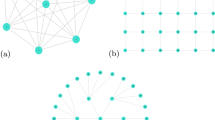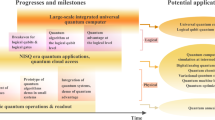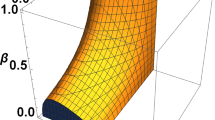Abstract
Quantum Fourier gates (QFG) constitute a complete family of quantum gates that result from an exact combination of the quantum Fourier transform (QFT) and the SWAP gate. Therefore, the Feynman Gate constitutes the simplest example of this family, while the Bell states are the simplest cases of entangled states derived from the family. Moreover, this new tool will allow us to demonstrate that teleportation is not something that happens exclusively thanks to maximally and non-maximally entangled states, but that it is also possible with an incomplete form of entanglement known as rough entanglement. Finally, other applications necessary for the quantum Internet are incorporated.


























Similar content being viewed by others
Data availability
The experimental data that support the findings of this study are available in ResearchGate with the identifier https://doi.org/10.13140/RG.2.2.24802.20161.
References
Adhikari, S., et al.: Teleportation via maximally and non-maximally entangled mixed states. ACM, Quant. Inf. Comput. 10(5), 398–419 (2010)
Behera, B.K., et al.: Demonstration of entanglement purification and swapping protocol to design quantum repeater in IBM quantum computer. Quant. Inf. Process. 18, 108 (2019)
Bennett, C.H., et al.: Teleporting an unknown quantum state via dual classical and Einstein–Podolsky–Rosen channels. Phys. Rev. Lett. 70(13), 1895–1899 (1993)
Cacciapuoti, A.S., et al.: The quantum internet: networking challenges in distributed quantum computing. IEEE Netw. 34(1), 137–143 (2020a)
Cacciapuoti, A.S., et al.: When entanglement meets classical communications: quantum Telepor-tation for the quantum internet. IEEE Trans. Comm. 68(6), 3808–3833 (2020b)
Caleffi, M., et al.: The rise of the quantum internet. Computer 53(06), 67–72 (2020)
Campbell, S., Paternostro, M.: Teleporting bipartite entanglement using maximally entangled mixed channels. Int. J. Quant. Inf. 8(1–2), 105–119 (2010)
Cariolaro, G.: Quantum Communications: Signals and Communication Technology. Springer, N.Y. (2015)
Gruska, J. Quantum computing (McGraw-Hill, N.Y., 1999–2005)
Gyongyosi, L., Imre, S.: Entanglement access control for the quantum Internet. Quant. Inf. Process 18, 107 (2019a)
Gyongyosi, L., Imre, S.: Opportunistic entanglement distribution for the quantum internet. Sci. Rep. 9, 2219 (2019b)
Gyongyosi, L., Imre, S.: Entanglement accessibility measures for the quantum internet. Quant. Inf. Proc. 19, 115 (2020)
Hiskett, P.A., et al.: Long-distance quantum key distribution in optical fibre. New J. Phys. 8, 193 (2006)
IBM quantum experience, https://quantum-computing.ibm.com/ (last accessed 5 April 2022)
Joy, D., et al.: Implementation of quantum secret sharing and quantum binary voting protocol in the IBM quantum computer. Quant. Inf. Process. 19, 33 (2020)
Koniorczyk, M., Bužek, V.: Nonmaximally entangled bases and their application in entanglement purification via swapping. Phys. Rev. A 71, 032331 (2005)
Kumar, N., et al. (eds.): Limitations and Future Applications of Quantum Cryptography. IGI Global, Hershey (2021)
Mastriani, M.: Fourier’s quantum information processing. SN Comput. Sci. 2, 122 (2021a)
Mastriani, M.: On the spectral nature of entanglement. IET Quant. Comm. 2, 8–13 (2021b)
Mastriani, M.: Quantum Fourier transform is the building block for creating entanglement. Sci. Rep. 11, 22210 (2021c)
Mastriani, M.: Fourier behind entanglement: a spectral approach to the quantum internet. Ann. Phys. 524, 1 (2021d)
Mehic, M., et al.: Quantum key distribution: a networking perspective. ACM Comput. Surveys 53(5), 96–914 (2020)
Nielsen, M.A., Chuang, I.L.: Quantum Computation and Quantum Information. Cambridge University Press, N.Y. (2004)
Quantum Inspire by QuTech, https://www.quantum-inspire.com/ (last accessed 5 April 2022)
Quantum programming studio, https://quantum-circuit.com/ (last accessed 5 April 2022).
Quirk simulator, https://algassert.com/ quirk (last accessed 5 April 2022)
Rigetti, https://qcs.rigetti.com/ (last accessed 5 April 2022)
Roy, S., Ghosh, B.: A revisit to non-maximally entangled mixed states: teleportation witness noisy channel and discord. Quant. Inf. Process 16, 108 (2017)
Ruihong, Q., Ying, M.: Research progress of quantum repeaters. IOP J. Phys. Conf. Ser. 1237, 052032 (2019)
Sharma, V.: Feasibility of temperature sensors in railway coaches. Int. J. Sci. Eng. Res 5(2), 881–884 (2014)
Sharma, V.: Effect of noise on practical quantum communication systems. Def. Sci. J. 66(2), 186–192 (2016)
Sharma, V., Banerjee, S.: Quantum communication using code division multiple access network. Opt. Quant. Electron. 52(8), 1–22 (2020)
Sharma, V., Panchariya, P.C.: Experimental use of electronic nose for odour detection. Int. J. Eng. Syst. Modell. Simu. 7(4), 238–243 (2015)
Sharma, V., Sharma, R.: Analysis of spread spectrum in MATLAB. Int. J. Sci. Eng. Res 5(1), 1899–1902 (2014)
Sharma, V., Shrikant, U., Srikanth, R., Banerjee, S.: Decoherence can help quantum cryptographic security. Quant. Inf. Process. 17, 1–16 (2018)
Sharma, V., Gupta, S., Mehta, G., Lad, B.K.: A quantum-based diagnostics approach for additive manufacturing machine. IET Collab. Intell. Manuf. 3(2), 184–192 (2021)
Sharma, V. Analysis of single photon detectors in differential phase shift quantum key distribu-tion. arXiv preprint arXiv:2307.03593 (2023)
Sharma, V., Banerjee, S. Analysis of quantum key distribution-based satellite communication. In: 2018 IEEE 9th International conference on computing, communication and networking technologies (ICCCNT), 1–5 (2018).
Sharma, V., Bhardwaj, A. Analysis of differential phase shift quantum key distribution using single-photon detectors. In 2022 IEEE International conference on numerical simulation of optoelectronic devices (NUSOD), 17–18 (2022)
Shor, P.W.: Polynomial-time algorithms for prime factorization and discrete logarithms on a quantum computer. SIAM J. Comput. 26(5), 1484–1509 (1997)
Acknowledgements
Not applicable
Funding
The author has not disclosed any funding.
Author information
Authors and Affiliations
Contributions
MM conceived the idea and fully developed the theory, developed the experiments on the simulator and the optical table, wrote the complete manuscript, prepared figures, and reviewed the manuscript.
Corresponding author
Ethics declarations
Conflict of interest
The author declares no competing interests.
Ethical approval
Not applicable.
Additional information
Publisher's Note
Springer Nature remains neutral with regard to jurisdictional claims in published maps and institutional affiliations.
Rights and permissions
Springer Nature or its licensor (e.g. a society or other partner) holds exclusive rights to this article under a publishing agreement with the author(s) or other rightsholder(s); author self-archiving of the accepted manuscript version of this article is solely governed by the terms of such publishing agreement and applicable law.
About this article
Cite this article
Mastriani, M. Quantum Fourier states and gates: teleportation via rough entanglement. Opt Quant Electron 55, 1111 (2023). https://doi.org/10.1007/s11082-023-05299-2
Received:
Accepted:
Published:
DOI: https://doi.org/10.1007/s11082-023-05299-2




